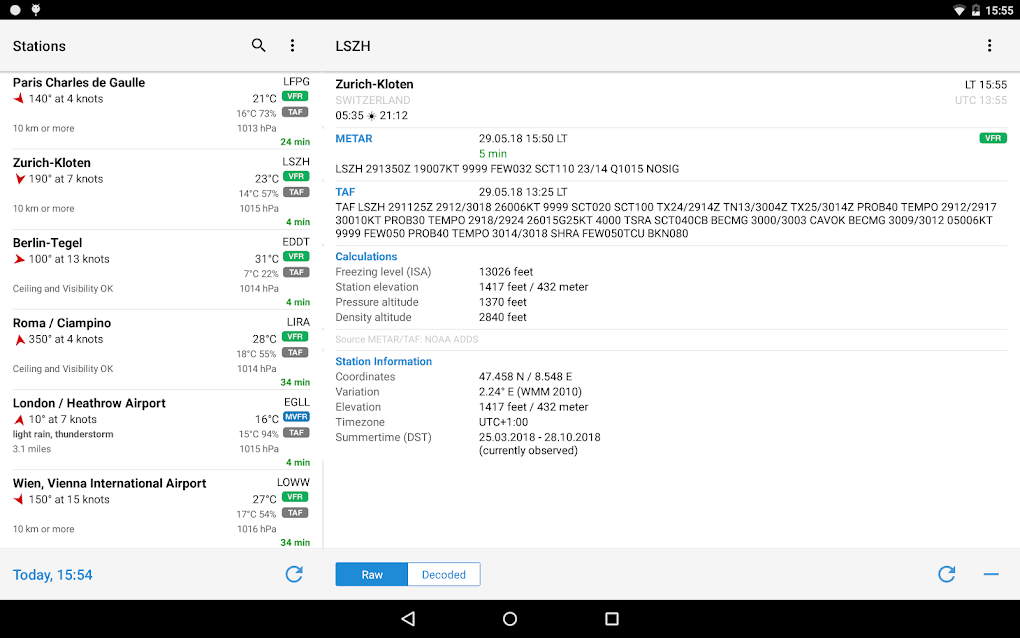
If only one coordinate could be extracted from a SIGMET, a circle with a 25 km radius is drawn around it. Current SIGMETs are drawn on the map with yellow polygons or circles. They warn pilots for icing, mountain waves, ash clouds, heavy turbulence and thunderstorms. (Visual Flight Rules, Marginal VFR, Instrument Flight Rules, Low IFR) On the map above you only see the first letter of the color code. These color codes do not tell anything about the temperature, wind, type of clouds and other warnings. The color codes you see on the site are calculated based on the visibility values and cloud base.
#AEROWEATHER DOWNLOAD FREE#
Sign up for a free account to set and save your preferences. In addition to a decoded METAR and TAF, you will also see the crosswind components. If there is no METAR station on that airport, we will show the closest METAR in combination with the runways of the chosen space. Click on a field to view the METAR, TAF and NOTAMs. The interactive map shows the most recent data from all METAR stations in the world. These shortcomings are overcome by METAR decoders such as. You can of course calculate this with a few rules of thumb or a sine / cosine, but that is not convenient. You also cannot see whether there is a crosswind: from which direction, at what speed. You cannot see at a glance whether there is a head or tail wind. A METAR does not provide information about wind components.For countries far removed from this (North and South America, Asia, Australia), this provides quite a bit of calculations. Times are in UTC (Coordinated Universal Time): the time in London without daylight saving time.You don't use most of them on a daily basis, which makes it difficult to remember them all. 50 codes are used for weather phenomena and the condition of the runways.A METAR or TAF can be set up with other units than you are used to and you have to convert.Sometimes it is difficult to quickly visualize all the information it contains. Yet encrypted METAR and TAFs do have their limitations. The information from one round (cycle) of all approximately 4,200 measuring stations together is still about 3 Mb. This is done in a standardized way to avoid misunderstandings. A lot of information can be passed on with few characters.

That seems very outdated in the year 2023, but it is not. DistributionĪfter compilation, the METAR is distributed in an encrypted format. Most weather stations provide a new observation every half hour. Sometimes a METAR is automatically prepared and then checked or supplemented by a meterologist. Both are prepared for aviation and contain weather information that pilots need.Ī METAR is prepared by a meteorologist or automatically. A TAF (Terminal Area Forecast) provides a forecast for a longer period, for example 8, 24 or 36 hours. This is prepared when the weather has changed such that an interim observation is issued.Ī METAR (METeorological Aerodrome Report) is an observation and provides information about the current weather. In addition to the METAR and TAF, there is also a SPECI (special). Sometimes a METAR also gives a short-term forecast.Ī TAF (Terminal Area Forecast) provides a forecast for a longer period, for example 8, 24 or 36 hours. But what's the difference and how do you use them? METAR, TAF or SPECIĪ METAR (METeorological Aerodrome Report) is an observation and provides information about the current weather. They mainly contain information about the weather, but also information about the runway conditions. Both are prepared for aviation and contain weather information that pilots need. METAR, TAF and NOTAM decoder for all 77,824 airports


 0 kommentar(er)
0 kommentar(er)
